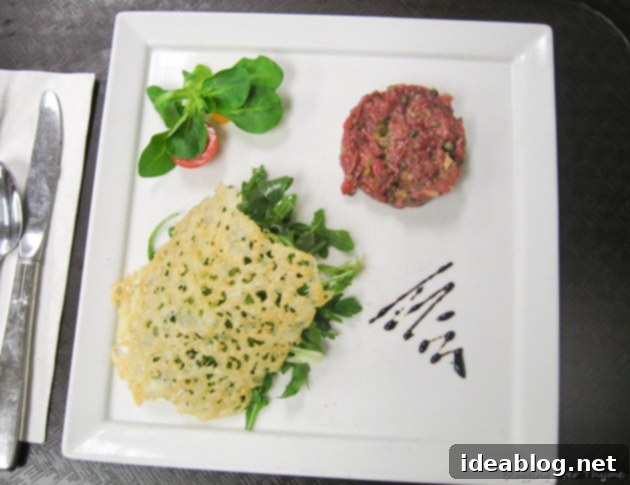Culinary School Diaries: Mastering Classic Dishes, Epic Challenges, and Market Basket Triumphs
Another week has begun, and the pace of culinary school continues its relentless, exhilarating march! The past weekend flew by, leaving us little time to rest before diving back into the intensive daily grind of refining our culinary skills and tackling complex gastronomic challenges. Every day brings new lessons, demanding techniques, and unforgettable dishes that push the boundaries of our knowledge and precision in the kitchen. This entry will delve into a recent day’s intricate menu, explore the anticipation surrounding a massive upcoming banquet, and recap our inaugural Market Basket challenge, which tested our creativity and adaptability under pressure.
Today’s Culinary Journey: A Glimpse into the Day’s Menu
Today’s curriculum presented another packed and diverse menu, requiring a blend of technical precision and artistic flair. From a daring appetizer to a robust main course and an elegant dessert, each dish served as a crucial learning experience in our journey toward culinary mastery. The day emphasized the importance of using fresh, high-quality ingredients and meticulous execution, especially when dealing with delicate and potentially risky preparations.
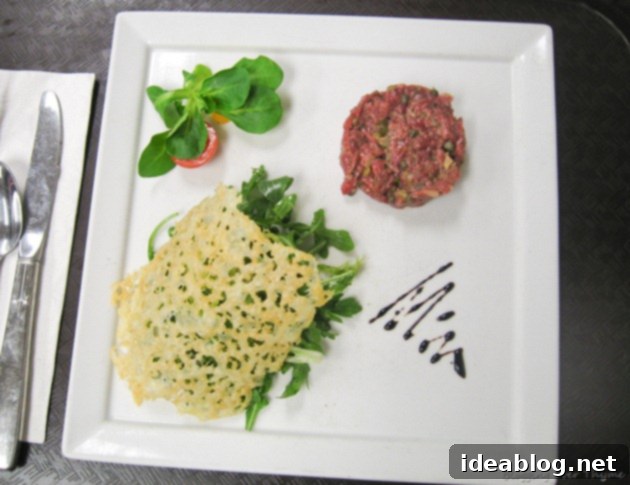
The Art of Classic Steak Tartare
Our first course was a classic Steak Tartare, a dish that epitomizes precision and respect for raw ingredients. This sophisticated appetizer is a vibrant medley of finely minced raw lean, red meat—for which we utilized top round, known for its tenderness and flavor—combined with a symphony of acidic and savory components. The mixture typically includes finely diced cornichons, briny capers, sharp Dijon mustard, pungent red onion, a dash of Tabasco for heat, and Worcestershire sauce for umami depth. Lemon juice provides essential brightness, cutting through the richness and ‘cooking’ the raw meat subtly through denaturation. All these elements are carefully bound together with fresh raw egg yolks, creating a luscious texture and unifying the diverse flavors.
The preparation of Steak Tartare is not merely about chopping and mixing; it demands an unwavering commitment to food safety and ingredient integrity. Given that the dish relies entirely on raw beef and raw egg, the absolute freshness of every component is paramount. Our chef instructors underscored the critical need for meticulous temperature control throughout the preparation process and stringent sanitation practices to prevent any health risks. Furthermore, to maintain optimal freshness and prevent oxidation, all ingredients are mixed together at the very last minute, ensuring the vibrant flavors and appealing color remain intact for serving.
While the concept of raw beef can be daunting, especially with contemporary health concerns, the technical execution and aesthetic presentation of this dish were undeniably impressive. It challenges preconceived notions and highlights the importance of traditional techniques in fine dining. Despite personal reservations about consuming raw meat, the dish taught invaluable lessons about ingredient quality, knife skills, and the art of balancing bold flavors.
Crafting Delicate Parmesan Tuiles
To complement the richness of the Steak Tartare, we served it alongside a crisp arugula salad, elegantly topped with a delicate Parmesan Tuile. These ingenious crisps are surprisingly simple yet incredibly effective in adding texture and a concentrated savory punch. The process involves placing small, circular mounds of freshly grated Parmesan cheese onto a Silpat mat, then baking them until they achieve a light golden hue and a lacy, delicate structure. The true artistry, however, lies in the immediate post-baking phase. Once out of the oven, the tuiles are still pliable and must be very quickly molded into their desired shape—in our case, draped over a bottle to create a graceful curve—before they cool and become rigid. This requires speed, efficiency, and having all equipment pre-positioned, as timing is everything. It’s a pure expression of Parmesan, offering an intense flavor that perfectly complements the peppery arugula and rich tartare.
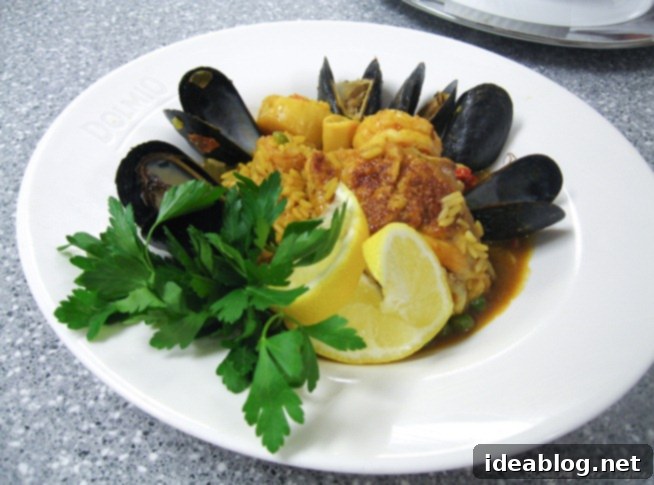
A Taste of Spain: Perfecting Paella
Our main course transported us to the sun-drenched coasts of Spain with a magnificent Paella. This quintessential Spanish rice dish was a truly delicious and complex creation, brimming with a delightful combination of proteins. Our version featured tender chicken, succulent mussels, plump shrimp, tender squid, and delicate scallops, all harmoniously cooked into a saffron-infused rice base. The secret to an exceptionally flavorful paella lies not just in the fresh seafood and chicken, but in the foundation of a richly flavored stock. To achieve this depth, we meticulously prepared a complex stock prior to cooking the paella itself. This stock was a culmination of roasted chicken bones, various vegetable scraps, an assortment of seafood scraps (most notably shrimp shells, which impart a fantastic brininess), a dedicated fish fumet (fish stock) for intensified seafood flavor, and additional chicken stock to round out the base. This multi-layered stock infusion ensures that every grain of rice and every piece of protein in the paella is imbued with an extraordinary depth of flavor, elevating it far beyond a simple rice dish. The communal nature of paella preparation also fostered a great sense of teamwork and shared culinary endeavor, making the process as rewarding as the final, fragrant dish itself.
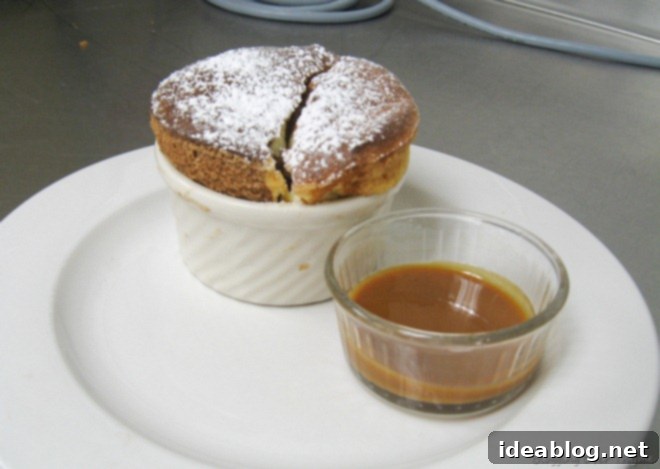
Sweet Endings: The Elegance of Chocolate & Grand Marnier Soufflés
To conclude our elaborate meal, we crafted a delicate and impressive Chocolate & Grand Marnier Soufflé. This was our first foray into making soufflés in Phase II, though we had tackled both savory and sweet versions in Phase I. This time, there was a noticeable improvement in everyone’s success, perhaps due to a deeper understanding of the foundational techniques. We reinforced the crucial lesson that the basic base of a soufflé, providing its structure and flavor, is a well-made pastry cream (crème pâtissière), specifically one thickened with flour rather than cornstarch, which offers greater stability and a more traditional texture for soufflés.
To make these soufflés particularly special and visually appealing, we employed an innovative technique: using folded foil to create a divider within each ramekin. This allowed us to separate the soufflé mixture into two distinct halves—one infused with rich chocolate, and the other with the fragrant, orange-flavored Grand Marnier liqueur. While the subtle division is somewhat challenging to discern in the photograph, it made for a fun and sophisticated presentation, offering diners a delightful two-in-one flavor experience. The process involved careful layering and precise baking to ensure both halves rose evenly to their ethereal heights.
We served these elegant soufflés with a luscious caramel sauce. The traditional and most theatrical way of serving soufflés involves bringing them to the table, poking a hole into the airy masterpiece directly in front of the guest, and then pouring the warm sauce directly into its heart. This method not only enhances the flavor but also adds a captivating element of dining theater. While the demand of the kitchen meant our own portions were no longer as fluffy or warm by the time we had a moment to enjoy them, the experience of creating such a classic, technically demanding dessert was immensely gratifying and a testament to the skills we are steadily acquiring.
Preparing for the Ultimate Culinary Test: The Banquet Challenge
The afternoon was consumed with intensive discussions and meticulous planning for tomorrow’s formidable Banquet Challenge. This is not just another daily menu; it’s a monumental test of our collective culinary prowess, organizational skills, and ability to perform under high pressure. We are tasked with the daunting responsibility of preparing and serving a comprehensive 6-course meal for 75 people—an undertaking that encompasses the entire school community, including Phase I Pastry & Culinary students who will be attending sanitation classes for the next two days. The scale and complexity of this event are immense, requiring seamless coordination, precise timing, and consistent quality across a vast number of dishes.
Reflecting on our journey, it feels like only yesterday we were taking our initial sanitation classes, feeling completely overwhelmed and intimidated by the sheer volume and intricacy of professional kitchen operations. I distinctly remember wondering if we would ever reach the point where we could execute such an enormous task ourselves. Well, tomorrow is that day. The Banquet Challenge represents a critical milestone in our culinary education, a true simulation of the high-stakes environment of professional catering and large-scale event dining. It demands not only our technical cooking skills but also our abilities in menu planning, mise en place management, inventory control, and efficient service. The pressure is on, but so is the excitement to demonstrate how far we’ve come.
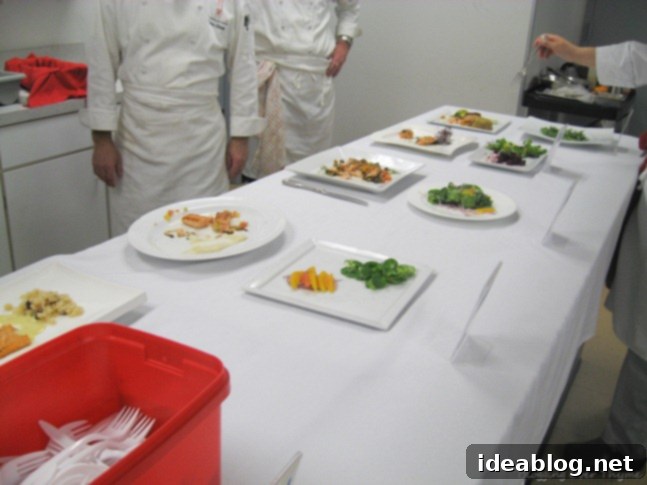
Reflections on the First Market Basket Challenge: Ingenuity Under Pressure
Beyond our daily curriculum and the looming banquet, one of the most significant and thrilling additions to Phase II is the introduction of nearly weekly Market Basket Challenges. These challenges are designed to cultivate creativity, quick thinking, and adaptability—essential traits for any successful chef. The format is both exhilarating and demanding: the day before the challenge, we are presented with a selection of mystery ingredients, each of which must be ingeniously incorporated into a cohesive 3-course meal. My teammate and I then have the afternoon to brainstorm, develop, and finalize our menu ideas. The following morning, the real test begins as we execute our planned menu under intense scrutiny. To elevate the stakes, visiting chefs from renowned establishments around the area come to the school to judge our plated dishes directly in front of us, and indeed, the entire class. The feedback is immediate, constructive, and often very direct, providing invaluable insights into professional expectations.
Our Debut Performance: Salmon and Salad
Last Friday marked our very first Market Basket challenge. As it was a half-day and our inaugural attempt, it was structured as a mini, one-course challenge focusing on a main dish paired with a side. Our primary ingredient was salmon, and the esteemed Director, Chef Francois, served as our judge. My teammate, Jim, and I collaborated to create a compelling dish: a perfectly Grilled Salmon Filet with a vibrant Lemon Parsley Sauce, elegantly presented atop a bed of expertly roasted zucchini and summer squash. For our accompanying side dish, we opted for a refreshing and balanced Baby Spinach Salad with a zesty Orange Vinaigrette, crunchy Toasted Almonds, bright Orange Segments, and thinly sliced Red Onions. This allowed us to showcase both cooking techniques and thoughtful flavor combinations.
Overall, the feedback we received was quite positive, which was incredibly encouraging for our first attempt. However, there was a memorable piece of constructive criticism regarding our roasted squash. Apparently, Chef Francois is not a connoisseur of roasted vegetables and found ours to be “a bit bitter.” This specific feedback, though perhaps subjective, served as a vital reminder that even seemingly simple elements of a dish can make or break a judge’s perception and that understanding preferences (even quirky ones) is part of the professional game. It was a valuable lesson in catering to diverse palates and meticulously refining every component of a plate.
Looking Ahead: The Next Market Basket and Beyond
The experience of our first Market Basket challenge has set a high bar, and we are already looking forward to our second one this coming Friday. This time, it will be a full three-course challenge, and the judging panel will feature an actual visiting chef, elevating the pressure and excitement even further. Each challenge is a unique opportunity to push our creative boundaries, refine our technical skills, and learn to perform under realistic industry conditions. The journey through culinary school is a continuous evolution, filled with demanding challenges and profound learning experiences that shape us into capable and confident chefs. Stay tuned for an update on our intensive Banquet Challenge tomorrow!
